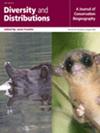The Effects of Protected Areas in Nepal as a Barrier Against Plant Invasions Are Associated With Lower Propagule Pressure and Less Intensive Disturbance
Abstract
Aim
Protected areas are established to conserve global biodiversity threatened by various factors, including invasive plants. We recorded naturalised alien plants inside and outside of protected areas to test whether they act as a barrier against the spread of alien plants.
Location
Five protected areas of Nepal on the central Himalayan foothills.
Methods
Using 6-km transects running 3 km inside and 3 km outside of the protected areas, we sampled 30 m × 30 m plots at 300 m intervals and analysed how the representation of naturalised plants changed with increasing distance from the boundary in both directions. The relationships between the position on a transect and naturalised species richness and Shannon diversity were tested by generalised linear mixed-effect models and linear mixed-effects models, respectively. Further, we used regression trees to identify variables potentially confounded with the distance from the park boundary. Then, we calculated the GLMM and LMM models accounting for the selected confounded variables. Multivariate constrained ordination analyses were performed to test the effects of elevation, tree canopy, vegetation type, disturbance, propagule pressure, distance from the park boundary, time since the park establishment and location inside versus outside protected areas on the composition of naturalised species.
Results
Chitwan National Park harboured most naturalised species (30), followed by Suklaphanta (20), Parsa (19), Bardia (18) and Banke National Park (17). Overall, the richness and Shannon diversity of naturalised plants were significantly higher outside than inside the protected areas. When all protected areas were evaluated together, naturalised plant species richness and diversity decreased significantly from the outside to the interior of the parks, even after accounting for the selected potentially confounded factors.
Main Conclusions
Naturalised plant species are less represented within protected areas than outside their boundaries, which is partly due to lower propagule pressure and less intensive disturbances.


 求助内容:
求助内容: 应助结果提醒方式:
应助结果提醒方式:


